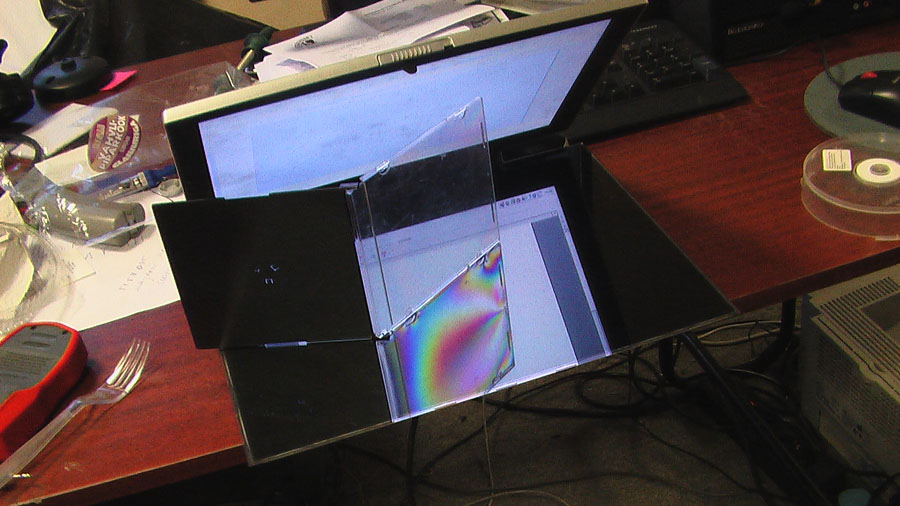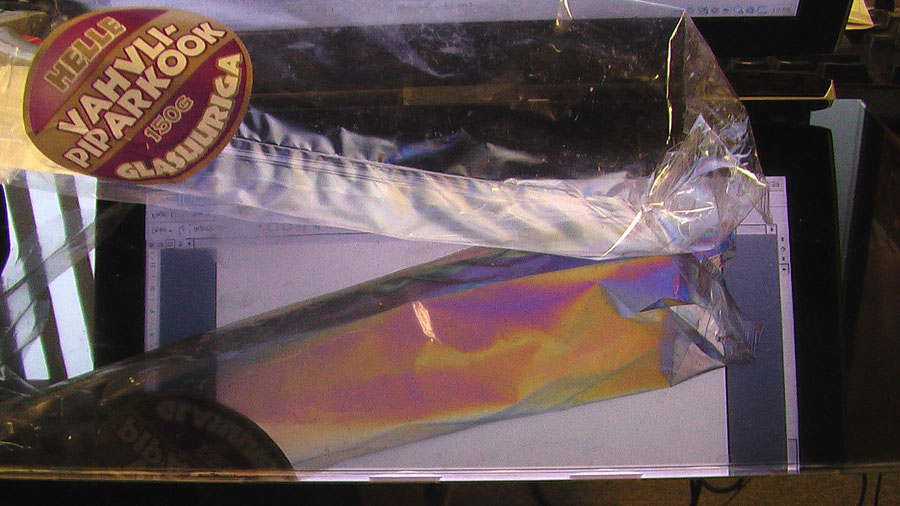
Of the polarizing effects with a laptop
by Aare Baume, Estonia
Some weeks ago I had in my hands one LCD computer monitor. It was broken, so I had no problems to open and dismantle it. (See Safety footnote.)
After separating the main parts, my desk looked like this:

One piece of electronics and two very thin fluorescent lamps to backlight the screen.
One piece of plexi plate, covered with white small quadrants.
One piece of dark thin plate.
At first, all the pieces seemed to be not useful. But only for a short time...
Some days of experimenting with the so-called dark plate brought me closer to the special optical effect, of that I shall explain now.
I switched on my laptop and chose Word program. It can be any other program as well. The main idea is to use a screen to emit white light at maximum level.
The dark plate was put to the keyboard with reflective side up.
Next thing was to tilt the screen so, that light emitting from the laptop screen can be seen from the plate's reflective surface.
I used the CD cover, spoon and plastic wrap for cookies as transparent objects for experimenting.

The colors appearing are common for polarizing light. The effect is seen, because light from a laptop screen is polarized, too. Any transparent object between two polarized plates shows these colored bands, showing the mechanically stressed parts as holes, sharp corners, etc.
Objects for further experiments could be chosen from nature, such as wings of flies, dragonflies, ice, etc.
Photographing of these objects and downloading them to the same computer would be simple. Happy readers with a scrap LCD monitor may like to design his or her own experiments (think about drop of sugar for wasps on the plate) and I encourage everybody openly to discuss about results. It is not known yet, if the sunlight blocks the effect or adds something new. Also, professional photographic polarizing filters may be adapted for such experimenting.
Happy experimenting!
Article was published in Estonian magazine called 'Loodusesõber', ( 'Nature for kids') February, 2009.
Aare Baumer is executive director of the Children's Science centre, 'Energiakeskus' in Tallinn, Estonia.
The main activities are amateur science and science communication.
Comments to the author Aare Baumer are welcomed.
Micscape Safety Note:
It is advisable for broken electrical / electronic items to be only dismantled by experienced adults.
If dismantling an LCD monitor, ensure no
chemicals such as liquid crystals which are poisonous are released. The chemical
volumes in the typically 5 um liquid cystal layer are however, small, see this
link, but take care and consult safety guidelines for liquid crystal release
before dismantling.
The fluorescent backlights may also contain mercury vapour
if broken.
Micscape Disclaimer: It is up to the reader to assess
any potential safety issues either electrical or chemical and take appropriate
precautions. Microscopy-UK, Micscape and contributors accept no responsibility
for property damage and harm to the person.
Published in the February 2009 edition of Micscape.
Please report any Web problems or offer general comments to the Micscape Editor .
Micscape is the on-line monthly magazine of the Microscopy UK web site at Microscopy-UK
©
Onview.net Ltd, Microscopy-UK, and all contributors 1995
onwards. All rights reserved.
Main site is at
www.microscopy-uk.org.uk
with full mirror
at
www.microscopy-uk.net
.